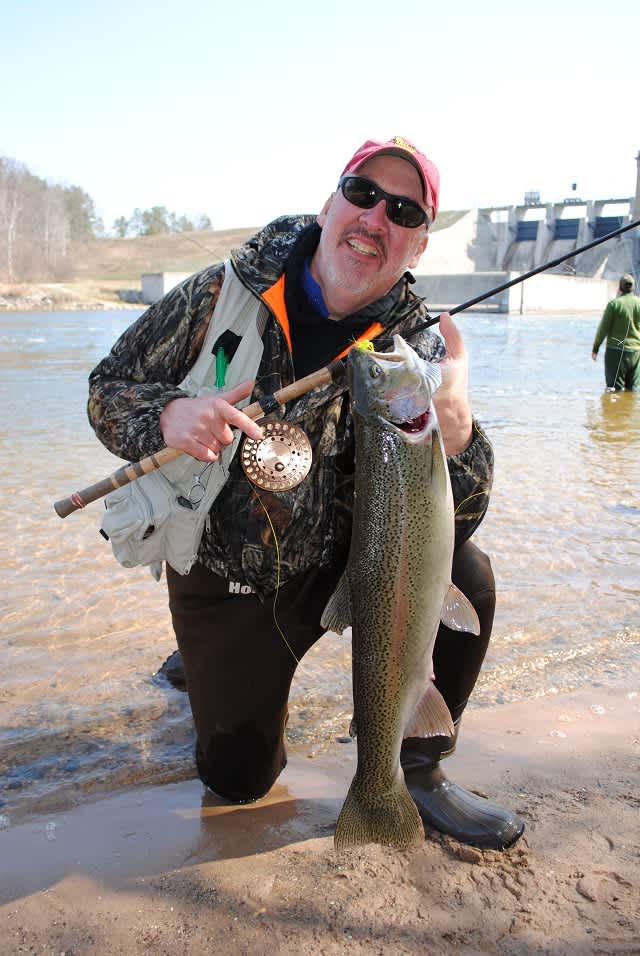Make Way for Center Pin Steelhead and Salmon Fishing on Michigan Streams
Steve Griffin 11.16.12

Spell it ‘center’ or ‘centre,’ or just call it ‘pinning.’ However you name it, using center pin fishing gear to offer salmon and steelhead a float-suspended bait or lure is catching anglers as well as salmonids.
Long practiced in Europe and simmering for decades on Canadian steelhead streams, center pinning has in the past decade taken Michigan streams by storm.
Two features make the set-up distinctive. The rod is long–at least 11 feet, more commonly 13, and sometimes 15–and the reel resembles a fly reel except that its arbor rests on exquisite bearings (sometimes, in lower price reels, bushings) that let it spin freely.
The long rod holds the line off the water; the reel spools off line so effortlessly that a float and its load are carried downstream to unsuspecting fish practically drag free.
That all assumes an effective cast. And in truth, that feat comes slowly to most of us.
Line can come off the center pin reel in two ways: spooling off a reel set spinning by a skilled caster or coiled off the spool to the side of the reel, echoing the work of a spinning reel and, like one of those, adding a twist to the line.
The easiest cast begins with a little tug, and the line within a thumb-forefinger ring pull out to the side. The digits become the rod’s first ring guide. It’s easy, but you pay in twisted line. Most newcomers–and many seasoned ‘pinners–just cut their line back when the coils come.
Gradually, most ‘pinners begin to start the cast with a sharp but measured tug downward, timing it so the reel spins just ahead of the line’s flight.
Best bet? Get someone to show and coach you.
For many anglers, their introduction to center pinning mirrors mine:
I’d listened to a friend laud the tactic for two full seasons before buying my own entry level gear (still dear, at a bit over $200 for rod and reel). The day after it arrived, I still took my old, battered bottom bouncing gear to Tippy Dam on the Manistee River. Chicken is what I was.
But I chatted with some ‘pinners there, admitted I’d left my new stuff home, and took them up on their offer to coach me the next day if I but returned with my stuff.
I did, and they did, and less than two hours after hitting the bottom of the stairs on the south side of the river, I slid a beautiful male steelhead onto the sand. It, obviously, was hooked.
I, almost as obviously, was hooked more.

Center pinning teaches you more about river currents than any method I know. You’re most successful when you guide floats and lures along the seams where river currents adjoin, so you learn to read them. You spend less time tying on tackle because you’re not consistently dredging the bottom.
Strings of shot pinched onto the leader to ‘load’ a bobber (‘pinners call ‘em floats) so it barely stays up also deliver the lure or bait (often, both) to fish level in a hurry. And when a fish strikes, the battle is intimate; most center pin reels are direct drive, although more each year are equipped with drags. Either way, each turn of the reel is a small victory over the fish.
Drawback? Cost, mainly. Reels start at $150 or so and quickly reach double that and beyond. You can spend several hundred dollars on a rod, although makers such as Shimano are bringing more nice $100 sticks to the market all the time.
Maybe the hardest thing about center pinning is taking a chance: allowing yourself those early mishaps and tangles that make success all the sweeter.
Oh, and one more challenge? Deciding how to spell the name of your new favorite fishing method!
For more information on Michigan fishing go to michigan.org.

